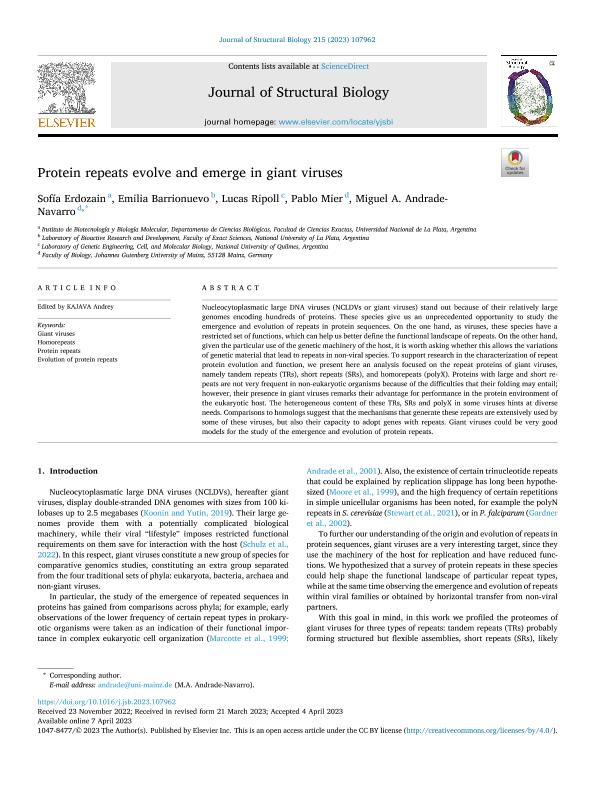Mostrar el registro sencillo del ítem
dc.contributor.author
Erdozain, Sofía
dc.contributor.author
Barrionuevo, Emilia Mercedes

dc.contributor.author
Ripoll, Lucas

dc.contributor.author
Mier, Pablo
dc.contributor.author
Andrade Navarro, Miguel A.
dc.date.available
2023-12-28T13:49:40Z
dc.date.issued
2023-06
dc.identifier.citation
Erdozain, Sofía; Barrionuevo, Emilia Mercedes; Ripoll, Lucas; Mier, Pablo; Andrade Navarro, Miguel A.; Protein repeats evolve and emerge in giant viruses; Academic Press Inc Elsevier Science; Journal Of Structural Biology; 215; 2; 6-2023; 1-11
dc.identifier.issn
1047-8477
dc.identifier.uri
http://hdl.handle.net/11336/221795
dc.description.abstract
Nucleocytoplasmatic large DNA viruses (NCLDVs or giant viruses) stand out because of their relatively large genomes encoding hundreds of proteins. These species give us an unprecedented opportunity to study the emergence and evolution of repeats in protein sequences. On the one hand, as viruses, these species have a restricted set of functions, which can help us better define the functional landscape of repeats. On the other hand, given the particular use of the genetic machinery of the host, it is worth asking whether this allows the variations of genetic material that lead to repeats in non-viral species. To support research in the characterization of repeat protein evolution and function, we present here an analysis focused on the repeat proteins of giant viruses, namely tandem repeats (TRs), short repeats (SRs), and homorepeats (polyX). Proteins with large and short repeats are not very frequent in non-eukaryotic organisms because of the difficulties that their folding may entail; however, their presence in giant viruses remarks their advantage for performance in the protein environment of the eukaryotic host. The heterogeneous content of these TRs, SRs and polyX in some viruses hints at diverse needs. Comparisons to homologs suggest that the mechanisms that generate these repeats are extensively used by some of these viruses, but also their capacity to adopt genes with repeats. Giant viruses could be very good models for the study of the emergence and evolution of protein repeats.
dc.format
application/pdf
dc.language.iso
eng
dc.publisher
Academic Press Inc Elsevier Science

dc.rights
info:eu-repo/semantics/openAccess
dc.rights.uri
https://creativecommons.org/licenses/by/2.5/ar/
dc.subject
EVOLUTION OF PROTEIN REPEATS
dc.subject
GIANT VIRUSES
dc.subject
HOMOREPEATS
dc.subject
PROTEIN REPEATS
dc.subject.classification
Ciencias de la Información y Bioinformática

dc.subject.classification
Ciencias de la Computación e Información

dc.subject.classification
CIENCIAS NATURALES Y EXACTAS

dc.title
Protein repeats evolve and emerge in giant viruses
dc.type
info:eu-repo/semantics/article
dc.type
info:ar-repo/semantics/artículo
dc.type
info:eu-repo/semantics/publishedVersion
dc.date.updated
2023-12-27T17:46:45Z
dc.journal.volume
215
dc.journal.number
2
dc.journal.pagination
1-11
dc.journal.pais
Países Bajos

dc.journal.ciudad
Amsterdam
dc.description.fil
Fil: Erdozain, Sofía. Universidad Nacional de La Plata. Facultad de Ciencias Exactas. Departamento de Ciencias Biológicas. Instituto de Biotecnología y Biología Molecular; Argentina
dc.description.fil
Fil: Barrionuevo, Emilia Mercedes. Universidad Nacional de La Plata. Facultad de Ciencias Exactas; Argentina. Consejo Nacional de Investigaciones Científicas y Técnicas. Centro Científico Tecnológico Conicet - La Plata; Argentina
dc.description.fil
Fil: Ripoll, Lucas. Universidad Nacional de Quilmes. Departamento de Ciencia y Tecnología. Laboratorio de Ingeniería Genética y Biología Molecular y Celular; Argentina. Consejo Nacional de Investigaciones Científicas y Técnicas; Argentina
dc.description.fil
Fil: Mier, Pablo. Johannes Gutenberg Universitat Mainz; Alemania
dc.description.fil
Fil: Andrade Navarro, Miguel A.. Johannes Gutenberg Universitat Mainz; Alemania
dc.journal.title
Journal Of Structural Biology

dc.relation.alternativeid
info:eu-repo/semantics/altIdentifier/doi/http://dx.doi.org/10.1016/j.jsb.2023.107962
dc.relation.alternativeid
info:eu-repo/semantics/altIdentifier/url/https://www.sciencedirect.com/science/article/pii/S1047847723000254
Archivos asociados
